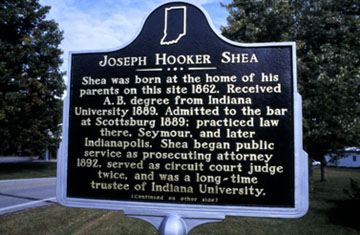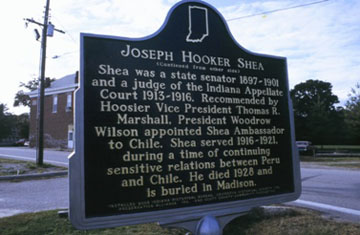

Location: 8060 E. Main Street/SR 356, next to fire station, Lexington (original site of family home). (Scott County, Indiana)
Lexington Historical Society, Inc., Preservation Alliance, Inc., and Scott County Community Foundation
ID# : 72.2003.1
Text
Side one:
Shea was born at the home of his parents on this site 1862. Received A.B. degree from Indiana University 1889. Admitted to the bar at Scottsburg 1889; practiced law there, Seymour, and later Indianapolis. Shea began public service as prosecuting attorney 1892, served as circuit court judge twice, and was a long-time trustee of Indiana University.
Side two:
Shea was a state senator 1897-1901 and a judge of the Indiana Appellate Court 1913-1916. Recommended by Hoosier Vice President Thomas R. Marshall, President Woodrow Wilson appointed Shea Ambassador to Chile. Shea served 1916-1921, during a time of continuing sensitive relations between Peru and Chile. He died 1928 and is buried in Madison.
Keywords
Politics
Annotated Text
Shea was born at the home of his parents on this site 1862.(1) Received A.B. degree from Indiana University 1889. Admitted to the bar at Scottsburg 1889; practiced law there, Seymour, and later Indianapolis.(2) Shea began public service as prosecuting attorney 1892, served as circuit court judge twice, and was a long-time trustee of Indiana University.(3)
Shea was a state senator 1897-1901 and a judge of the Indiana Appellate Court 1913-1916.(4) Recommended by Hoosier Vice President Thomas R. Marshall, President Woodrow Wilson appointed Shea Ambassador to Chile. Shea served 1916-1921, during a time of continuing sensitive relations between Peru and Chile.(5) He died 1928 and is buried in Madison.(6)
Notes:
(1) Enumeration Sheet, Population Schedule, 1870 U.S. Census; Shea Family Bible; Shea's tombstone; Scott County Journal and the Chronicle, June 30, 1966; Lexington, A Pioneer Town (Lexington, Indiana, 1988), 30. Biographical Directory of the Indiana General Assembly (Indianapolis, 1980), 1:351-352, and various other sources, incorrectly list 1863 as birth date.
(2) Burton Dorr Myers, Trustees and Officers of Indiana University, 1820-1950, (Bloomington, Indiana, 1951) p. 410; Who was Who in America (Chicago, 1943), Vol. 1; John Bernard Stoll, History of the Indiana Democracy, 1816-1916, pp.1017-18. According to Indiana Chief Justice Randall Shepard, during the nineteenth century "admittance to bar" did not require a license, just the endorsement of a local judge upon presentation of credentials. Phone conversation, August 23, 2002. Biographical Directory mistakenly lists 1885 as date of admittance to bar.
(3) Myers, 410; Stoll; Who was Who; Biographical Directory, Vol. I; Scott County Journal, December 26, 1928; Leander J. Monks, Courts and Lawyers of Indiana (Indianapolis, 1916), 3:1218-19; Indianapolis Star, December 23, 1928.
(4 ) Francis M. Trissal, Public Men of Indiana: A Political History from 1860-1890 (Hammond, Ind., 1922), pp.185-86; Journal of Indiana State Senate during the Sixtieth Session of the General Assembly (Indianapolis, 1897), 1, 5; Indiana University Alumni Quarterly, 16 (April 1929), 233; New York Times, March 4, 7, 1916; Biographical Directory; Vol. 1; Indiana Yearbook, 1917 (Indianapolis, 1918), p. 862; Indiana Court of Appeals Web site, Chronological Listing accessed April 18, 2001.
(5) Indianapolis News, March 1, 1916; Indianapolis Star, June 25, 1921; New York Times, March 4, 7, 1916, April 2, December 17, 1920; U.S. State Department Web site, Educational and Cultural Affairs, U.S. Chiefs of Mission, by Country, 1778 –2001 accessed April 30, 2002; Indiana University Alumni Quarterly, 3 (April 1916): 214. Salvatore Bizzarro, Historical Dictionary of Chile (1987), 474, describes the "Tacna Question" a dispute that lasted from 1880 until a treaty was signed in 1929.
(6) Myers, 411; Scott County Journal, December 26, 1928; Indianapolis Star, December 23, 1928.
